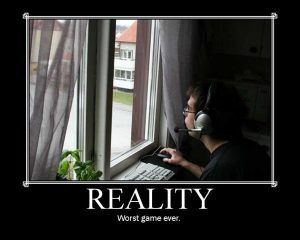In 2012, I wrote an article on Gamasutra, one of the leading game industry news sites, about gamification – “Gamification: the Misunderstood Dirty Word”
Surprisingly, it still holds up. Half a decade later, here’s the overview along with a few recent revisions.
Gamification – what is it?
Gamification is still pretty misunderstood.
“Gamification” is, in essence, the process of using game mechanics and game design to enhance things that aren’t games.
In the marketing and startup world, this concept is being heavily embraced and making a lot of people a lot of money right now, whether they have experience in game design and deserve that money or not. Similar to the buzzword of social media, the true experts at social media are the people who were experts at communication and social mechanics that took their knowledge and applied it to online networks.
In this case, the true experts at gamification are the video game companies that have been applying game design and game mechanic concepts to actual games for decades. But the industry still doesn’t like the term.
Understandably so.
It’s like turkey bacon
In 2012, attended a great panel at PAX East entitled, “If I hear ‘gamification’ one more time I’m going to scream,” consisting of professionals technically working with companies or organizations focusing on gamification. One of the speakers, Bill Sabram of MeYouHealth, worded it well when asked, “what does gamification mean for gamers?”
“It’s an affront,” said Sabram. “People want to take the soul of games, tear it out then sprinkle it on other things. Most gamers want to protect what’s awesome about games. They want it to be genuine and respect what games do.”
“It’s like turkey bacon,” added Monty Sharma, of Mass Digital Games Institute.
But the current perspective on gamification doesn’t have to be a negative one for people in the game industry. There are a lot of issues with the term “gamification” being over-used and over-abused from a marketing and selling perspective. This just doesn’t have to be the case.
Setting expectations
Gamers can be at peace with this term, so long as marketers and money-makers stop mishandling the concept. And honestly, a lot of good can come from gamification and making reality a bit more fun. Here are a few guidelines on what gamification is, what it isn’t, and how we can clear up this misunderstanding:
- Gamification is not new. Same as the buzzword concept of social media – this book can help explain how people already know everything about social media, at its core. Gamification tends to just take what makes games sticky and help retain people, but doesn’t constitute an actual game. Rewarding dedication is nothing new.
- Done right, gamification is a good thing. Games teach you things, whether you realize it or not. And then you retain the things you learn from games through repeat behavior and stimulus. Using these mechanics to help other fields teach other ideas is a good thing.
- People slapping the “gamification” label onto things isn’t going to help anyone. Chefs can give out recipes but unless you’re an expert, you won’t do it well. Make sure if you go forward with any gamification efforts, you talk to people who actually know game design, not just marketing or sales people trying to latch on to the next big thing.
A personal note: I was the Marketing Director for a video game developer and now I’m the Business Director at Exothermic – I know I’m no expert on what are good game mechanics and what makes things fun. I defer to the experts I’ve worked with for over half a decade now, the game designers, on all issues involving gamification. I know there is much that I do not know.
- Badges and achievements aren’t a game. Those are part of games, sure. But that’s not a game in itself. Rules don’t matter if you don’t care – that just cheapens a system.
- There are many existing abuses of gamification. Casinos have gamified losing money. People plan on losing money when they play those games. This is why it gets a bad name. Another simple example of gamification abuse is having a tag on your keys at the grocery store that costs you $5 if
 you forget to bring it along. Grocery stores and restaurants have been using gamification for years, it was just typically referred to as loyalty programs instead of using this new buzzword.
you forget to bring it along. Grocery stores and restaurants have been using gamification for years, it was just typically referred to as loyalty programs instead of using this new buzzword.
- Some learning objectives are brought out by games better than others. We have to accept that gamification is more effective in some areas than others. Things like health care, education, and other fields are prime opportunities for gamification – just look at Fitocracy (and a great example of how it can be abused).
- For gamification to succeed, the developers need to be better funded. Companies are expecting game developers or companies with “gamification expertise” to produce gamified apps or gamification training programs based on next-to-nothing amounts compared to the actual dollars spent on creating traditional video games. Until the funding increases, the results will always be less than stellar when compared to typical video games.
- Gamification is already the creation of other industries. Raph Koster offered a great speech at GDC 2012 discussing the differences between “good” game design and “great” game design. At its very core, though, everything in game design relates back to other fields like psychology, business, architecture, and more. What game design has done is take elements from these fields and apply them to games. Gamification simply takes these lessons and reapplies them again to other fields.
For more information: check out some of the current thought-leaders like Jane McGonigal, Jesse Schell and Joey Lee. Even half a decade later, these people are still paving the way in this space.
Some of my personal favorites in regards to gamification-done-right include Khan Academy, Fitbit, foldit, Stack Overflow, and two edutainment/serious game staples of my childhood: The Oregon Trail and Where in the World is Carmen Sandiego?
At Exothermic, we work with serious games studios who are veterans of the game industry to do gamification the best way possible. Contact us if you have questions about using gamification for your brand and want to chat.
